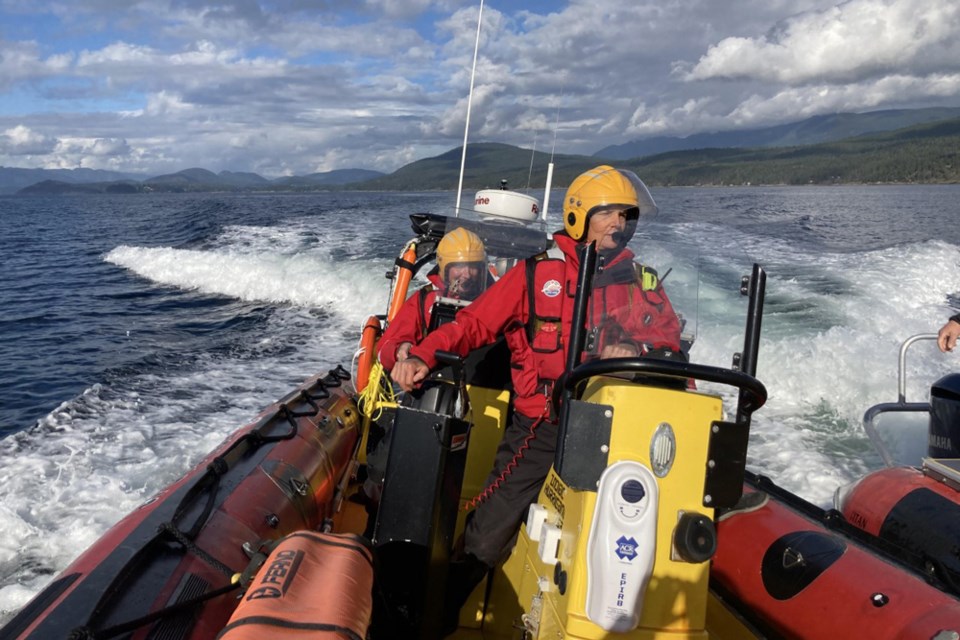Among locals, there’s no single reason to call the Sunshine Coast home. But to understand a big part of the region’s attraction, you only need to see its hundreds of kilometres of shoreline, inlets that carve their way into the coastal mountains, and pristine wilderness laced with rugged hiking trails.
But, of course, all that West Coast wilderness isn’t without its dangers. Fortunately, crew members with the Halfmoon Bay Royal Canadian Marine Search and Rescue (RCMSAR) are ready to respond should something go wrong.
And now, following a significant investment from TELUS, calling for help is easier and faster than ever.
Driven by a long-standing commitment to the Sunshine Coast, over the last two decades TELUS has invested $100 million in both community giving projects and network infrastructure — from cell towers to world-leading PureFibre network technology — across the region. Earlier this year, TELUS more than doubled its commitment, investing another $150 million in network, infrastructure and community projects through 2035.
Those improvements mean boaters, paddlers and hikers can access the TELUS wireless network across much of Sechelt Inlet.
All that connectivity adds to the search-and-rescue toolkit – and that means more lives saved when emergency strikes.
“The ability for people to call for help now in more remote areas means we’ve seen a better result in searches and avoiding unnecessary callouts,” says RCMSAR station leader Adam Hoult.
With many nautical miles of shoreline to cover, even in perfect conditions it can take upwards of 45 minutes for the RCMSAR boat to get to the popular Skookumchuk Narrows, despite it looking close on a map.
“People may not feel they’re that far away from civilization, but services are far,” says Hoult. “The sooner you can get us going, the sooner we can mitigate whatever is happening.”
While a lot of issues can be avoided with good preparation — for example, making sure a boat is seaworthy and hasn’t been sitting all winter; letting loved ones know where you’re going and when you’re expecting to return; having the right safety equipment — Hoult says the ability to use a cellphone is valuable.
That’s especially true in the unusual waters of Sechelt Inlet, including those around the Skookumchuk Narrows, North America’s largest tidal rapid, which Hoult describes as “impressive and terrifying.”
A popular destination on the coast, it’s also incredibly dangerous — both on the water and on shore when the tide drains out, leaving behind a slippery surface.
Previously, when something went wrong, people would have to hike more than two hours to the mouth of the trail to call for help. Now they can phone from the scene.
The new cell towers are already helping.
This summer, a hiker fell into a crevasse and became wedged between two rocks on the shoreline. People passing by found him and reached out for help, making a quick call from the site.
“We’ve seen a faster notification of any kind of situation since the towers have gone up,” says Hoult, adding the hiker was ultimately OK.
With thousands of hours invested in training every year, Hoult says crews are ready to respond to a call, even if it’s a case of someone losing track of time because they’re having fun exploring the area.
“People don’t mind going out to make sure someone is OK,” he says.
Now that people can call on their own if they run into trouble, or even if they just want to inform friends and family of a delayed return — without the time lag that comes from someone phoning emergency services or contacting the Joint Rescue Co-ordination Centre out of Victoria because a loved one is overdue — so much the better.
Improved connectivity also helps by offering last-known locations, which can help narrow a search — a crucial boost when dealing with the vast amount of shoreline — and text messages can go through even in more remote areas.
“I have another tool I can use to find somebody,” says Hoult. “The improved cellular coverage allows us to keep everyone as safe as possible on the water.”
